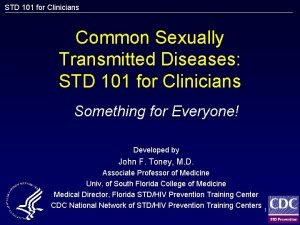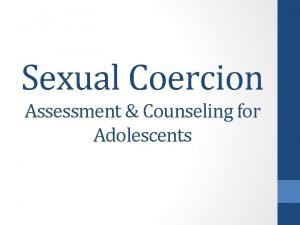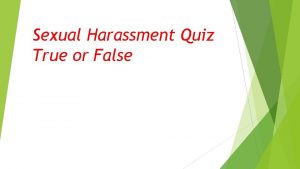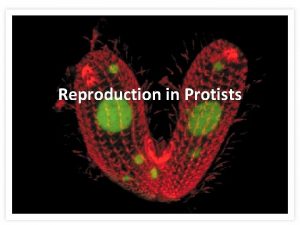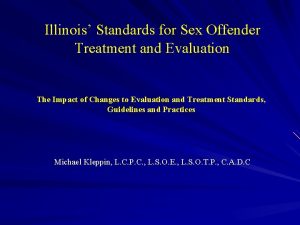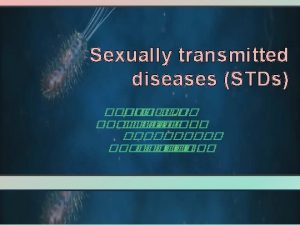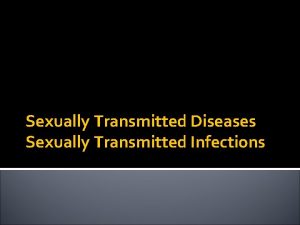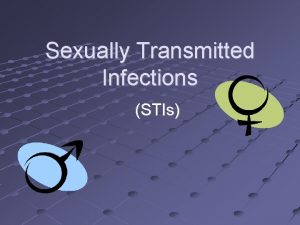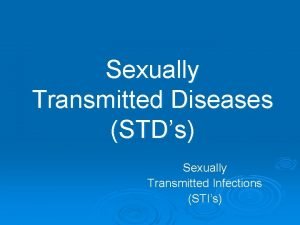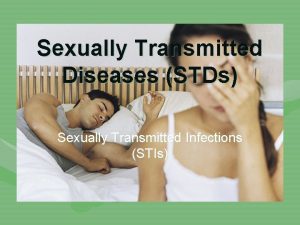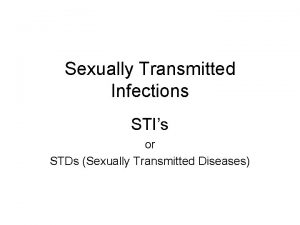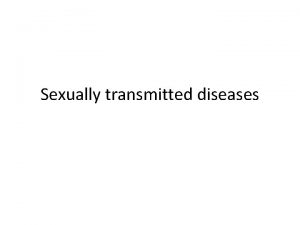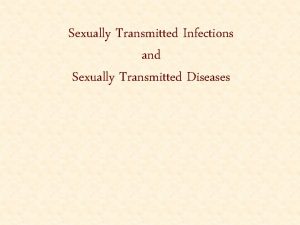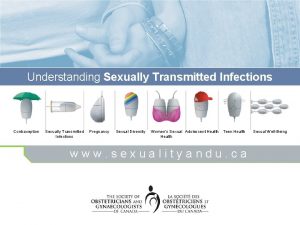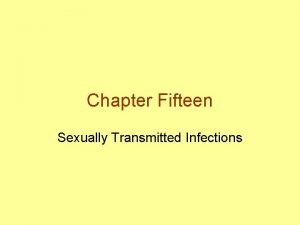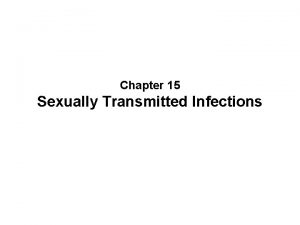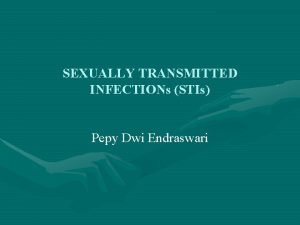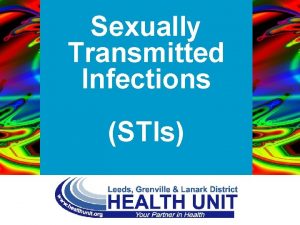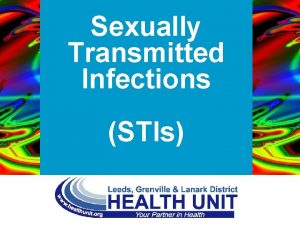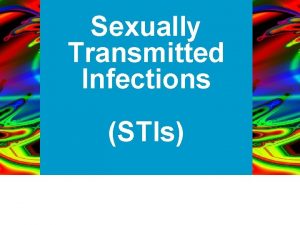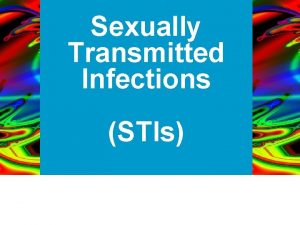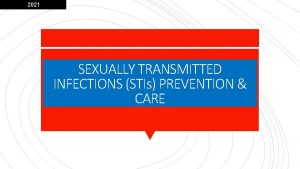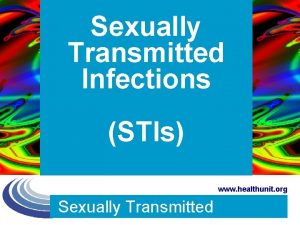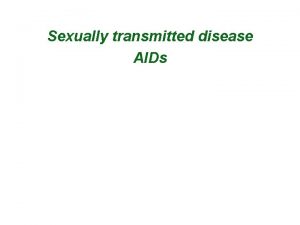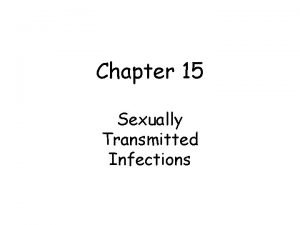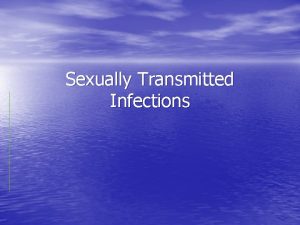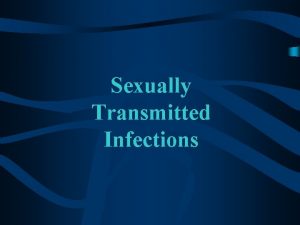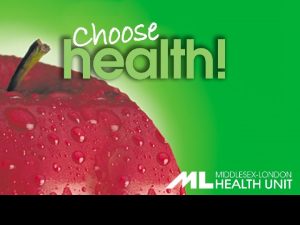Sexually Transmitted Infections STIs Update 2014 Joseph M































- Slides: 31

Sexually Transmitted Infections (STIs) Update: 2014 Joseph M. Gastaldo, MD Ohio. Health, Riverside Methodist Hospital April 23, 2014

Evolution of words. . . Venereal Disease (VD): venereus (Venus; Roman goddess of love); relating to sexual intercourse or desire; term lost favor in late 20 th century Sexually Transmitted Disease (STD) symptomatic Sexually Transmitted Infection (STI) term introduced by public health officials; more inclusive; may be symptomatic or asymptomatic

What are STIs & How are They Transmitted ? Caused by more than 30 different bacteria, viruses, & parasites & are spread predominantly by sexual contact (vaginal, oral, anal) Pathogens with greatest incidence of illness: syphilis, gonorrhea, chlamydia, trichomoniasis HBV, herpes, HIV, HPV Variable presentation: vaginal discharge, urethral discharge in men, oral or anogenital ulcers, abdominal pain, asymptomatic

Objectives / Outline Recognize the public health burden & spectrum of pathology associated with STIs Understand the association of STIs and risk of HIV transmission; STI prevention is part of HIV prevention Appreciate the common presentation and disease spectrum associated with various STIs; recognize treatment regimens Have an appreciation to the complexity of a practicing venereologist

CDC Statistics April is STD Awareness Month STIs are a significant health challenge; costing the nation an estimated $16 billion annually 20 million new STIs annually; half among persons ages 15 -24 years Reported data is only a fraction of the true burden; many cases of chlamydia, gonorrhea, & syphilis go undiagnosed & underreported; HPV, HSV, trichomoniasis are not routinely reported CDC. Gov Fact Sheet; 2012

WHO Statistics who. int More than 1 million people acquire an STI every day Each year, an estimated 500 million people become ill with one of 4 STIs: chlamydia, gonorrhea, syphilis, and trichomoniasis More than 530 million people have the virus mostly associated with genital HSV (HSV 2) More than 290 million women have HPV infection The majority of STIs are present without symptoms

Estimated new cases of curable STIs (gonorrhea, chlamydia, syphilis, trichomoniasis), 2008 who. int

STIs: Widespread Health Implications Infertility/reproductive health: pregnancy complications, infertility, PID Neonatal health: in utero & perinatal transmission; stillbirth, pneumonia, congenital deformities Int J Gyn Ob. 2013 Dec; 123(3): 183 -4 J Fam Pract 1990 Apr; 30(4): 448 -56 Malignancy: worldwide, HPV infection causes 530 K cases of cervical cancer (275 K deaths) Antibiotic resistance: gonorrhea with evolving resistance to ceftriaxone Transmission of HIV; STD prevention is part of HIV prevention WHO fact sheet; updated 2013; who. int Expert Rev Anti In Ther 2014 Apr 4

Strong association between STIs & Increased risk of HIV infection Curr Opin HIV AIDS Jul 2010; 5(4): 305 -10 Infections that disrupt the epithelial surface of the genital tract facilitate the access of HIV to target cells under the epithelial surface Ulcerative diseases: herpes, syphilis inflammatory conditions: trichomoniasis Observed striking increase in the prevalence of concordant HIV infection & syphilis HIV patient: conditions that recruits PMNs to the genital tract are associated with increase in HIV shedding BMJ 1989; 298(6674): 623 -4 CID (2007) 44(9): 1222 -8 STDs 2008; 35(11): 946 -59

STIs & HIV Infected Persons In HIV infected persons, new STIs are events that signal HIV exposure to others Baltimore City HD; 796 men/354 women diagnosed with HIV from 1993 -8; 13. 9% of men & 11. 9% of women were diagnosed with an STI after there HIV diagnosis Higher risk for HIV/STI coinfections: MSM, minorities, lower socioeconomic class JAIDS 33: 247 -52 AIDS Behav 2011 15(sup 1)

Dr. Gastaldo’s Suggestions for Intervention; slide 1 Assume that all HIV infected/STI patients are sexually active ! (Duh) Sexual inquiries; lack of HCWs “comfort level”, lack of sensitivity, lack of training to sensitive questioning. Risk behavior counseling: mental health screening, substance abuse/PNP, “hook up” smart phone apps Routine STI screening: syphilis antibody, NAAT for gonorrhea & chlamydia

Dr. Gastaldo’s Suggestions for Intervention; slide 2 Safe sexual practice discussion Discussion & consideration for Pr. EP in appropriate HIV (-) person Immunizations: HAV, HBV, HPV: ACIP recommends vaccination with HPV 4 through age 26 in: MSM, immunocompromised males, HIV infected males

Pathogens / Presentation / Treatment Bacterial: syphilis, gonorrhea, chlamydia Protozoa: Trichomonas vaginalis Viruses: HSV, HPV

Neisseria gonorrhoeae CDC. gov, practice guidelines Gram (-) diplococcus; infects surfaces lined with columnar epithelial cells (endocervix, urethra, anogenital, oropharyngeal, conjuctiva); always considered a pathogen Men: usually causes symptomatic urethritis, up to 25% may be asymtomatic, epididymitis: most frequent complication MSM, screening: urethral, rectal, & pharyngeal infection (NAAT)

Neisseria gonorrhoeae CDC. gov, practice guidelines Women: up to 50% asymptomatic; cervicitis, perihepatitis, PID, perinatal morbidity Both sexes: anorectal infection, pharyngitis, conjuctivitis, disseminated infection (tenosynovitis, severe: meningitis, IE) Incubation period: 3 -7 days in men, unclear in women (10 days? ) Diagnosis: culture & gram stain: only test that determines antibiotic sensitivity; gram stain alone is diagnostic for urethral (SYMPTOMATIC men) testing; preferred method when dx unclear; used to confirm positive NAAT result in low prevalence areas, culture all sites will increase yield NAAT: routinely used for urine, vaginal, penile/urethral (FDA approved) more rapid turnaround time than culture; use culture for dx from extra-genital sites (rectal & pharyngeal) unless the lab has conducted internal validation of noncultured based method (Quest Diagnostics & Laboratory Corporation of America have validated)

Neisseria gonorrhoeae: Rx CDC. gov, practice guidelines Resistance rates (>25%) to fluoroquinolones: No Oral cephalosporins are not preferred Uncomplicated infections of cervix, urethra, rectum, & pharynx: 250 mg IM plus azithromycin 1 gram single dose or PO doxycycline for 7 days Disseminated infections: IV ceftriaxone; consideration to PO antibiotic transition 24 -48 hours after improvement; meningitis/IE: IV ceftriaxone Evaluate & treat partners (for specific circumstances, other regimens exist, but TOC needed)

Chlamydia trachomatis CDC. gov, guidelines Does not gram stain; intracellular; D-K biovars: GU infection; L serovars: lymphogranuloma venereum (LGV); systemic infection; genital ulcer-adenopathy syndrome Only 10% of men & 5 -30% of women develop symptoms Spectrum of disease: urethritis, cervicitis, PID, epididymitis, prostatitis (rare), protitis, colitis, pharyngitis, sexually associated reactive arthritis, SARA, formerly known as Reiter’s syndrome MSM: 3 -10% test positive on rectal screening; 1 -2% on pharyngeal screening J Am Coll Health 60: 481, 2012 Testing: NAATs more sensitive than non amplification tests Endocervical, vaginal (self collected), urethral, oropharyngeal**, urine, rectal swabs** (not FDA approved, some labs have met CLIA requirements & validated NAAT testing on rectal swabs) Check with your lab.

Chlamydia trachomatis: Rx CDC. gov, practice guidelines Azithromycin 1 gram orally in a single dose or doxycycline 100 mg orally BID for 7 days. Treat sexual partners To minimize disease transmission, persons treated should obstain from sexual intercourse for 7 days after a single dose Rx or until 7 day Rx is complete Test of cure: pregnant women Infected persons should be retested 3 months after Rx; post treatment infection: re-infection

Syphilis; Treponema pallidum CDC. gov, practice guidelines Systemic infection; protean signs & symptoms Primary: chancre occurs at point of introduction/contact 10 -90 days after exposure; chancre can occur in many places Regional adenopathy; patient is contagious Untreated lesions spontaneously heal in 3 -6 weeks Diagnosis: examination, darkfield microscopy or DFA, RPR often (-) (painless, clean based ulcer with indurated edges)

Secondary syphilis; variable highly CDC. gov, practice guidelines “Copper penny” macular lesions on palms & soles, generalized or focal, non-puritic/painless Fever, malaise, anorexia, occasionally meningismus Onset up to 6 months after exposure Highly infectious; lesions will heal without Rx Diagnosis: RPR, high titers can be seen, examination

Early latent & latent syphilis CDC. gov, practice guidelines Early: asymptomatic period from spontaneous resolution of primary or secondary first year 25% will have relapse of secondary; patients considered infectious; unrecognized relapse Diagnosis: both non-trepomenal & treponemal tests (+) Late: asymptomatic infection; non-infectious evaluate for clinical evidence of teriary or ocular disease Diagnosis: serology, non-treponemal test may revert to normal Consider CSF exam if neurologic symptoms; HIV patient with neurologic symptoms

Neurosyphilis: can occur at any stage CDC. gov, practice guidelines Meningitis & eye disease may occur during primary or secondary stages & during the first 5 -10 years of untreated infection Syphilitic eye disease: uveitis, iritis, optic neuritis, neuroretinitis “Classic manifestations” after 15 -20 years of untreated infection: tabes dorsalis & general paresis (can be with psychotoc or dementia features) Diagnosis: CSF examination; serology (pleocytosis, elevated protein, VDRL)

Syphilis: Rx: penicillin CDC. Gov, guidelines Primary & secondary: benzathine PCN (BPG) 2. 4 mu IM as a single dose; allergy: 14 days doxycycline, 2 grams PO azithromycin: need CLOSE f/u; Jarisch-Herxheimer reaction Early latent: BPG IM times 1 dose Late latent or unknown: BPG IM q 7 days time 3 doses; being late >2 days not recommended Neurosyphilis/ocular: IV PCN-G for 10 -14 days consider desensitization with PCN allergy Pregnant women: use PCN; desensitize HIV: PCN is drug of choice

Syphilis: follow up CDC. gov, practice guidelines NTAT (RPR): 4 fold change in titer (2 dilutions) considered a significant change; use same test & lab NTAT usual revert to NR status over time; persistent low levels: serofast Treponemal EIA: identifies previously treated & untreated persons Neurosyphilis: if pleocytosis initially seen, repeat CSF every 6 months until cell count is normal; if cell count is not decreased at 6 months or normal at 2 years, consider re-treatment. HIV: RPR at 3, 6, 9, 12, & 24 months; failure: persistant or recurrent symptoms, sustained rise in RPR. If failure: consider CSF exam & retreatment; consider Rx for latent

Trichomonas vaginalis CDC. gov, practice guidelines Most common non-viral STI in US; Pear shaped, motile, flagellated protozoan parasite 7. 3 million estimated annual new cases Parasites invade superficial epithelium; inflammation; enhances acquisition of HIV infection; can survive up to 45 minutes on clothing & bathwater Women: 50% asymptomatic; vaginal discharge; profuse, sometimes frothy vulvovaginal irritation, “strawberry” cervix, consider PID with abdominal pain Men: up to 75% asymptomatic, urethritis, epididymitis, prostatitis, balantitis

Trichomonas vaginalis CDC. gov, practice guidelines Diagnosis women: microscopy of vaginal secretions (60 -70% sensitive), “whiff test”, , POC testing; nucleic acid probe tests (Affirm VP III), culture Diagnosis men: wet prep with poor sensitivity, no approved point-of-care tests; culture of urethral swab, urine, or semen APTIMA T. vaginalis Analyte Specific Reagents (ASR); detects RNA using same methodology for GC & Chlamydia; CLIA verification studies T. vaginalis has not been found to infect oral sites Rectal prevalence appears low in MSM p. H >4. 5

Trichomonas vaginalis: Rx CDC. gov, practice guidelines Uncomplicated: metronidazole 2 gr PO x 1 dose Cystitis, prostatitis, epididymitis: longer duration PO metronidazole with 95% cure rate Metronidazole gel: 50% efficacy; not recommended Low level metronidazole resistance: 2 -5% high level resistance is rare; retreat patients with 7 day course if Rx failure Metronidazole: Antabuse reaction; avoid Et. OH Treat partners

Herpes Simplex virus (HSV) “Most people infected with genital herpes do not know they have it” CDC. gov, practice guidelines HSV-1 & HSV-2, Herpes DNA virus family (HHV-1 & HHV-2) After primary infection, establishes latency in neurons, potential for reactivation, usually near site of primary infection Most infections are asymptomatic: HSV-1: 50 -80% of adults seropositive, HSV-2: 20 -40% of adults are seropositive (US data) HSV-1: herpes labialis most common form of recurrent HSV-1, 30% of genital HSV is HSV-1 Diagnosis for GU/mucocutaneous infx: clinical presentation; viral culture of ulcer/vesicle Primary infection: Asymptomatic in two-thirds of both HSV-1 & HSV-2; clinical presentation: vesicular infection; primary gingivostomatitis; mononucleosis syndrome; genital infection: small painful, clustered vesicles; shallow ulcerations; can be “systemically ill”

HSV: FYI CDC. gov, practice guidelines HSV-2 more likely to have clinical recurrences Genital ulcer disease (HSV, chancre) increases the risk of acquisition & transmission of HIV Psychological impact of HSV cannot be overestimated Both condom use & daily valacyclovir use: reduce the transmission course in discordant couples NEJM 350: 11, 2004 HIV infection: 60 -70% infected with HVS-2; disseminated/severe infections can occur with CD 4<200 Acute immunosuppression may reactivate

HSV: Rx CDC. gov, practice guidelines Acyclovir, valacyclovir*, famciclovir* Generally well tolerated; nausea, vomiting, HA Dose adjustment need for GFR < 50 m. L/min Dosing based on indication: use reference Valacyclovir: first episode of genital HSV: 1 gr BID for 7 -10 days Recurrent genital HSV: 500 mg BID (1 gr BID if severe) Suppressive therapy: 500 mg BID Herpes labialis: 1 gr q 12 hours for 2 doses

Saluti da Roma !
 Chapter 25 sexually transmitted infections and hiv/aids
Chapter 25 sexually transmitted infections and hiv/aids Nursing management of reproductive tract infection
Nursing management of reproductive tract infection Chapter 24 lesson 1 sexually transmitted diseases
Chapter 24 lesson 1 sexually transmitted diseases Std
Std Chapter 24 sexually transmitted diseases and hiv/aids
Chapter 24 sexually transmitted diseases and hiv/aids Sti std
Sti std Recovery techniques based on immediate update
Recovery techniques based on immediate update Bacterial vaginosis
Bacterial vaginosis Infections opportunistes digestives
Infections opportunistes digestives Opportunistic infections
Opportunistic infections Amber blumling
Amber blumling Storch infections
Storch infections Postpartum infections
Postpartum infections Can methotrexate cause yeast infections
Can methotrexate cause yeast infections Innate immunity first line of defense
Innate immunity first line of defense Storch infections
Storch infections Retroviruses and opportunistic infections
Retroviruses and opportunistic infections Opportunistic infections
Opportunistic infections Classification of acute gingival infections
Classification of acute gingival infections Bone and joint infections
Bone and joint infections Genital infections
Genital infections Understanding the mirai botnet
Understanding the mirai botnet Radial symmetry examples
Radial symmetry examples Coercion
Coercion Sexually dimorphic meaning
Sexually dimorphic meaning Have i been sexually harassed quiz
Have i been sexually harassed quiz African eye worm
African eye worm Freightment unpathetic
Freightment unpathetic Is phytoplankton a protist
Is phytoplankton a protist Protoctista reproduction
Protoctista reproduction Sexually dangerous persons act illinois
Sexually dangerous persons act illinois Atis sexually or asexually
Atis sexually or asexually



